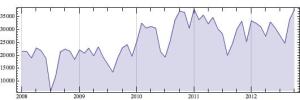By Mireille Mayrand-Fiset
Montreal, Quebec’s largest and most vibrant city, is known internationally for its joie de vivre, its festive ambiance and its open-mindedness. This reputation goes back a long while: from as early as New France, Montreal was known for being a joyful, pleasurable city. In 1721, François-Xavier Charlevoix, first historian of New France, wrote in his Journal of a Voyage Made in North America By Order of the King: “The City of Montreal has a most pleasant quality; is it well situated, well established and well constructed. The beauty of its surroundings, areas and vistas instils pleasure, felt by All.”
Montreal truly discovered its own potential of excitement during the twentieth century. Between the 1920s to the late 1960s, Montreal was one of the most lively, thrilling and somewhat decadent cities in North America. St-Laurent Boulevard, a.k.a “The Main,” was the epicenter of a effervescent nightlife: cabarets, gaming houses and brothels were everywhere, welcoming, at all hours of day or night, a crowd of night birds, many of whom came from the United States or Europe.
Here’s a glimpse at one of the most exciting pages of Montreal’s history; one which largely contributed to its modern uniqueness. Continue reading







